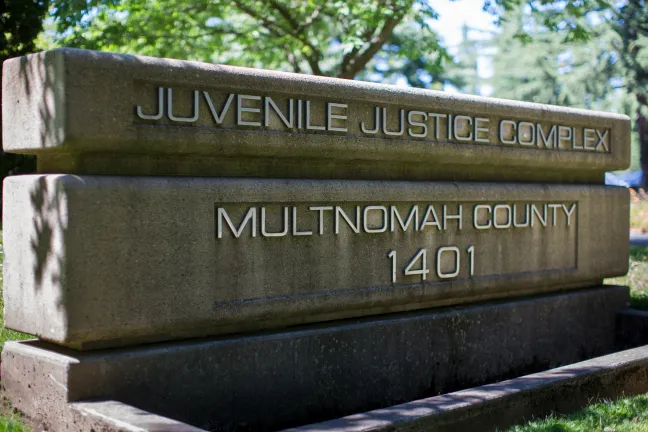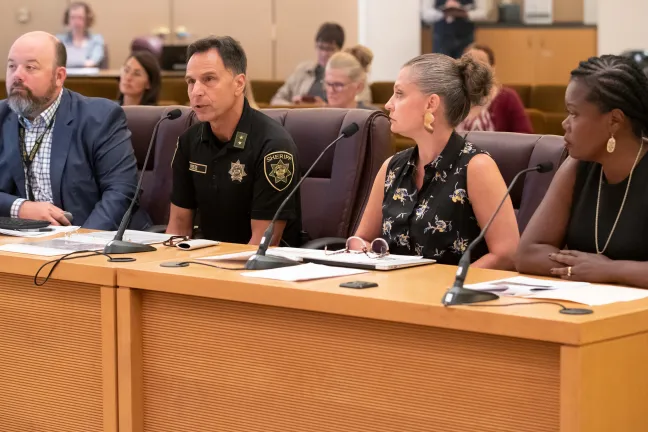The Multnomah County Board of Commissioners on Tuesday, April 14, heard important updates on efforts to protect staff and justice-involved individuals, and reduce strain on jails and law enforcement operations, in the face of the COVID-19 pandemic.
Speakers including Multnomah County Sheriff Mike Reese, Corrections Health Director Dr. Michael Seale and Department of Community Justice Director Erika Preuitt detailed several critical steps taken to safely reduce the jail population while increasing screenings and health and safety measures across the County’s detention centers.
“Everyone understands the gravity of the situation and has made rapid adjustments in how they do business,” said Chair Deborah Kafoury.
“The work we’ve done has prepared us better than most jurisdictions, but we know we need to go further and do more. With what’s happened in other jails across the country, we know the lives of our staff and the inmates are at risk.”
Partners in public health, law enforcement, circuit courts, the district attorney’s office, community justice, the defense bar, victims services advocates and local social services providers have been meeting remotely on a regular basis, said Abbey Stamp, executive director of the Local Public Safety Coordinating Council.
And while those conversations are focused on support for staff and justice-involved individuals in jails, Stamp said, “there’s been a beautiful collaboration” to address strain on the entire system.
Some examples:
Every law enforcement officer operating in Multnomah County can issue an officer's citation in lieu of booking into jail for misdemeanors, requiring a person to appear in court at a later, more appropriate date. This does not apply to those arrested on suspicion of more serious charges, such as domestic violence, sex crimes and violent crimes.
Many court trials and hearings have been postponed, with in-person court services significantly limited.
The District Attorney’s Office when reasonable, safe and appropriate, has responsibly supported some motions for release and will, when appropriate and in the interest of justice and public safety, support some incarceration sentences being delayed until a later date and
Weekly calls with the National Crime Victims Law Institute and a variety of victims services providers in support of enhanced communication and collaboration are occurring.
“We’ve been managing fires right now,” said Stamp. “But when this passes and as we prepare for a possible influx of COVID-19 again in the fall, we’ll be looking at what policies do we want to keep, what have we learned and what do we want to go back to.”
Parole and Probation
Employees with Multnomah County’s Department of Community Justice (DCJ) have made significant job adjustments, in a short amount of time, to support the statewide stay at home order, said Preuitt, the department’s director.
While many field offices are closed, services are still being provided, Preuitt said. Parole and probation officers and juvenile court counselors, are still responding to immediate public safety concerns. But nonessential check-ins with adults, youth and their families are being conducted via phone, Skype or FaceTime.
Monthly supervision fees for adults on parole and probation have been temporarily suspended to help address the economic impact faced by those reentering the community after incarceration. Community service programs have also been suspended for both adults and juveniles.
The County’s Juvenile Detention Center, a 24-hour operation in Northeast Portland, is open, but many of its accompanying programs are closed or curtailed to adhere to physical distancing measures.
Volunteer programs — inside detention — are on hold. Family members or guests are required to make appointments to see youth inside a no-contact room at the center.
But every day, Preuitt said, staff are providing opportunities for youth to connect with their family members over the phone. Youth also have access to daily exercise, recreation and educational activities.
“Mental health consultants meet regularly with youth,” Preuitt said. “Our care managers in corrections continue to provide physical health. We’re doing what we can for youth experiencing anxiety, on top of the struggles they are already experiencing.”
Before the COVID-19 pandemic, the Juvenile Services Division has actively worked to reduce reliance on secured detention. Currently, there are just 64 funded beds at the regional facility. In the midst of public health emergency, the division is being more intentional about releasing youth who can be safely released — back into the community.
As of Monday, April 13, capacity at the detention center was 53- percent with 34 youth, said Preuitt. “We’re really proud of the work of our juvenile court counselors,” she said. The department is also monitoring jail use on the adult side, said Preuitt. Over the past 4 weeks, the department has averaged 18 holds per week, that's down from 35.
The impact of the pandemic is being felt by other department units too. The Crime Victims Services Unit, has seen a consistent increase in calls for domestic violence service, Preuitt said.
“We are still receiving financial requests for survivor safety needs. And we are aligning resources so we’re able to do so,” she said. “We have advocates available to them in our department and we refer victims of all crimes to community services providers.”
Jails and Corrections Health
From the beginning of the COVID-19 pandemic the Sheriff’s Office has worked collaboratively with partners in public health and correction’s health, said Sheriff Reese. The office’s Homeless Outreach and Programs Engagement, or HOPE team, also continues to reach people in the community who don’t have a home.
“All of the decisions, policies and protocols we have put in place are vetted through the public health lens,” Reese said — guided by the region’s lead health officer, Dr. Jennifer Vines, and Dr. Paul Lewis, who came out of retirement to help the Sheriff’s Office specifically with COVID-19.
He said his office has monitored areas of concern and other data by regularly connecting with other county sheriff’s offices statewide, the Oregon State Sheriff’s Association, the Oregon Association of Chiefs of Police, and partners in the Local Public Safety Coordinating Council.
“Crime overall in Multnomah County is down significantly. Calls for police service are also down,” Reese said. “However, crime is highly localized so what one neighborhood is experiencing may not be true for another neighborhood.”
Domestic violence calls and reports are up, compared to last year. He said burglaries to businesses and calls about shots fired are also starting to tick up.
“We’re also patrolling closed areas in the Gorge to ensure everyone respects the closure,” said Reese.
The sheriff’s office has worked closely with the courts, the district attorney's office, the Department of Community Justice and other law enforcement partners to carefully reduce jail capacity. Beds are 62 percent full today, down from 92 percent one month ago, said Reese.
Other steps include:
- Additional housing units have been opened to spread out inmates, creating physical space around beds and lowering the number of people in dormitories.
- A unit of single person cells has been set up to house people, new to the jail system for up to 14 days, to allow for medical monitoring and separation from other people and
- Enhanced and more frequent cleaning and steps to protect the health of staff and those in custody.
Corrections Health Director Dr. Michael Seale described screening efforts that launched in late January. There are four main areas of focus:
- Individuals new to the system receive enhanced medical screenings prior to reaching the booking area. This includes screening for respiratory symptoms where individuals are asked a series of questions regarding contact with an ill person as well as travel, among other federal recommendations
- Individuals are given a mask at that time to protect others in booking. Those mask remains available while in custody.
- Before an individual is assigned to a housing unit, they are screened again for COVID-19 related symptoms. A temperature check is performed and they are asked a series of medical questions.
- Daily medical evaluations and temperature checks occur for 14 days, for every newly incarcerated person. Higher-risk individuals, including those older than 60, those who are immune-compromised or diagnosed with cancer, those with underlying medical conditions such as diabetes, lung disease and cardiovascular disease, and those who are pregnant are being screened for 30 days.
“These practices are focused on finding people early so we can intervene early,” Seale said. The screenings build on long-established protocols for managing outbreaks of other communicable and respiratory diseases, including influenza and tuberculosis.
We identify people who are ill through the screening processes and they are removed from the general population. And there are two units — one in each adult facility that have negative air flow capacity — or ventilation capacity to help prevent cross contamination from room to room.
“So we have the ability to move people into respiratory isolation,” he said.
We also have the ability to conduct COVID-19 testing in the jail facilities, he continued. To date (April 14), we’ve tested 3 individuals for COVID-19. All have been negative.
Criteria for testing in custody is broader than in the community. So even If someone isn’t quite showing symptoms he said, “If they are ill enough to go to the hospital, we would send them to the hospital.”
For those who might be identified in housing — it adds an additional issue of exposure to others in housing.
In that case, we would do contact tracing alongside further investigation of housing units, Seale said. We have the ability to place housing units on precaution, where we limit people in and out of housing units. “It gives us time to assess each person and identify those who can be placed in negative airflow rooms.”
Explanations of screenings and other measures are being explained in multiple languages —which is already common practice at the County facilities, he said. And there’s a heightened cleaning schedule inside the housing unit to help prevent spread of disease.
There are challenges, he admitted.
Protective Personal Equipment (PPE) is a challenge across the United States. Corrections Health made efforts early on to develop “surge capacity” — deferring non-urgent clinical activities when appropriate to help minimize the use of PPE for activities that are required.
“We’re trying to reserve N95 masks for when it’s clearly clinically necessary,” said Dr. Seale. "We have been able to work collaboratively with the Sheriff’s Office as they look for PPE. So that’s given us some ability to have enough should there be an outbreak.”
Staff, who work in the jails, are also being screened.
I want to add, said Reese, “Our front line employees are all essential, whether it’s correction staff, deputy sheriffs, corrections deputies in our facilities or our non-sworn staff. It’s exceptional work.”
On Tuesday morning, the Sheriff’s Office reported its first employee tested positive for COVID-19. The employee had been on leave for an extended period of time.
While public health officials believe the exposure likely occurred off duty and the risk of transmission is believed to be very low, “This continues to be a very difficult time, and I deeply appreciate everyone’s concern for our employee,” Reese said.
“We will continue to follow the guidance given by public health officials to protect our staff, adults in our custody and our community.”



